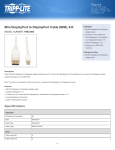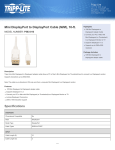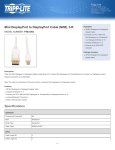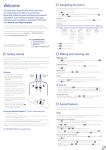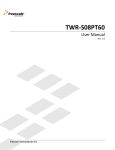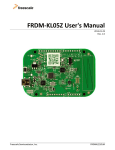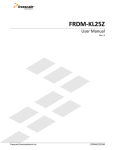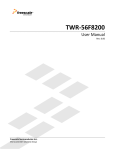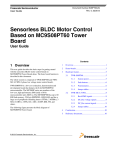Download FRDM-KE02Z User's Manual
Transcript
FRDM-KE02Z User’s Manual Rev. 0 Freescale Semiconductor Inc. FRDMKE02ZUM Table of Contents 1 Overview ................................................................................................................................... 4 2 Reference Documents ............................................................................................................... 4 3 Getting Started.......................................................................................................................... 4 4 FRDM-KE02Z Hardware Overview ............................................................................................. 5 5 FRDM-KE02Z Hardware Description .......................................................................................... 6 5.1 Power Supply .................................................................................................................... 6 5.2 Serial and Debug Adapter (OpenSDA) ................................................................................ 8 5.2.1 5.2.2 Debugging Interface ...................................................................................................................................... 9 Virtual Serial Port .......................................................................................................................................... 9 5.3 KE02Z Microcontroller ....................................................................................................... 9 5.4 Clock Source ...................................................................................................................... 9 5.4.1 Serial Port ........................................................................................................................ 10 5.4.2 Reset ............................................................................................................................... 10 5.4.3 Debug .............................................................................................................................. 10 5.5 Thermistor....................................................................................................................... 10 5.6 Infrared Port.................................................................................................................... 11 5.7 Capacitive Touch Slider.................................................................................................... 11 5.8 3-axis Accelerometer ....................................................................................................... 12 5.9 RGB LED .......................................................................................................................... 13 5.10 Input/Output Headers ..................................................................................................... 13 5.11 Arduino Compatibility...................................................................................................... 14 List of Figures Figure 1. FRDM-KE02Z Block Diagram ............................................................................................... 5 Figure 2. FRDM-KE02Z Power Supply ................................................................................................ 7 Figure 3. OpenSDA Block Diagram .................................................................................................... 9 Figure 4. SWD debug connector to KE02Z ......................................................................................... 9 Figure 5. Thermistor connection ..................................................................................................... 11 Figure 6. Infrared connection .......................................................................................................... 11 Figure 7. Touch Slider connection ................................................................................................... 12 Figure 8. Accelerometer connection ............................................................................................... 12 Figure 9. RGB LED connection ......................................................................................................... 13 Figure 10. I/O headers .................................................................................................................... 14 FRDMKE02ZUM FRDM-KE02Z User Manual Page 2 of 14 Revision History Revision 0 FRDMKE02ZUM Date 4/17/2014 Changes Initial version FRDM-KE02Z User Manual Page 3 of 14 1 Overview The Freescale Freedom development platform is an evaluation and development tool ideal for rapid prototyping of microcontroller-based applications. The hardware design is form-factor compatible with popular third-party hardware designed to work with Arduino™ and Arduino-compatible boards. The Freescale KE02Z freedom board (FRDM-KE02Z) is a simple, yet sophisticated design featuring a Kinetis E Series microcontroller KE02Z64VQH2, the industry’s first microcontroller built on the ARM® Cortex™-M0+ core with 0.18um process. The Kinetis E series is the most scalable portfolio of low-power, high-robustness, mixed signal 32-bit ARM Cortex-M0+ MCUs running up to 20MHz in the industry based on .18um process. It supports power supply voltage range from 2.7V to 5.5V, ambient operating temperature ranges from -40C to 105C and includes up to 64KB flash. The FRDM-KE02Z includes the Freescale open standard embedded serial and debug adapter known as OpenSDA. This circuit offers the user several options for serial communications, flash programming and run-control debugging. There are also many software development tool options available to the user. Choices include CodeWarrior for Microcontrollers, IAR Embedded Workbench, Keil MDK featuring the µVision IDE, Red Suite from Code Red Technologies, Atollic TrueSTUDIO, Rowley Crossworks, and more. All of these features combine to give the user the freedoms needed to rapidly prototype many embedded designs: a powerful microcontroller built on a very low-power core and SoC platform, easy-access to I/O with a large ecosystem of compatible hardware, a flexible programming and debug interface, and a large ecosystem of software development environments. Freedom! 2 Reference Documents OpenSDA User’s Guide KE02 Sub-Family Reference Manual Arduino Overview Arduino Uno - A guide for users of the OpenSDA embedded circuit. A reference manual for KE02 sub-family devices A guide of Arduion platform A guide of Arduion Uno revision 3 Getting Started Refer to the FRDM-KE02Z Quick Start Package for step-by-step instructions for getting started with the FRDM-KE02Z. See the Jump Start Your Design section on http://www.freescale.com/FRDMKE02Z for the Quick Start Package and software lab guides. FRDMKE02ZUM FRDM-KE02Z User Manual Page 4 of 14 4 FRDM-KE02Z Hardware Overview The FRDM-KE02Z hardware is a Freescale Freedom development platform platform microcontroller board assembled with the following features: • Kinetis E Series KE02 2 family MCU in an 64 QFP package (14x14 document number: 98ASB42844B) • On-board board serial and debug adapter (OpenSDA) • I/O headers for easy access to MCU I/O pins • Freescale inertial sensor, MMA8451Q • Capacitive touch slider • Reset pushbutton • RGB LED • infrared communication • 1 thermistor • Motor control header for simple BLDC motor control on APMOTOR56F8000E Figure 1 shows a block lock diagram of the FRDM FRDM-KE02Z board. Figure 1. FRDM-KE02Z Block Diagram The FRDM-KE02Z features two microcontrollers (MCUs): the target MCU and a serial and debug adapter (OpenSDA) MCU. The target MCU is a Kinetis E Series MA64 family device, the KE02Z64VQH2.. The OpenSDA MCU is a Kinetis Ki tis K Series K20 family device, the K20DX128VFM5. Features of the KE02Z64 target MCU include: • • • • • • • • • 32-bit ARM Cortex-M0+ core - up to 20 MHz operation - Single-cycle fast I/O access port Memories - 64 KB flash and 256B D-flash as EEPROM - 4 KB SRAM System integration - Power management and mode controllers - Low-leakage wakeup unit - Bit manipulation engine (BME) for read-modify-write peripheral operations Clocks - Clock generation module with FLL for system and CPU clock generation - 32 kHz internal reference clock - System oscillator supporting external crystal or resonator - Low-power 1kHz RC oscillator for RTC and watchdog Analog peripherals - 12-bit SAR ADC - Tow analog comparators Communication peripherals - Two 8-bit Serial Peripheral Interfaces (SPI) - one I2C modules - Three UART modules Timers - One 6-channel FlexTimer module - Two 2-channel Timer/PWM modules - 2-channel Periodic Interrupt Timer (PIT) - Real time clock (RTC) - System tick timer - One watchdog module Security - One CRC Human-Machine Interfaces (HMI) - General purpose input/output controller - IRQ 5 FRDM-KE02Z Hardware Description 5.1 Power Supply The FRDM-KE02Z offers a design with multiple power supply options. It can be powered from the USB connector, the VIN pin on the I/O header, an off-board 1.71-3.6V supply from the 3.3V pin on the I/O header or 3.3V from motor control header . The USB and VIN supplies are regulated onboard using a 3.3V linear regulator to produce the main power supply. The other two sources are not regulated on-board. The following figure shows the schematic drawing for the power supply inputs and the on-board voltage regulator. FRDMKE02ZUM FRDM-KE02Z User Manual Page 6 of 14 Figure 2. FRDM-KE02Z Power Supply Table 1 provides the operational details and requirements for the power supplies. Table 1. Power Supply Requirements 5V OpenSDA Operational? Yes Regulated onboard? Yes 4.3-9V No Yes 1.71-3.6V No No 3.3V Yes No Supply Source Valid Range OpenSDA USB (J7) VIN Pin on I/O header 3.3V Pin on I/O header 3.3V Pin on motor control header Note that the OpenSDA circuit is only operational when a USB cable is connected and supplying power to J6. However, the protection circuitry is in place to allow multiple sources to be powered at once. Table 2. FRDM-KE02Z Power Supplies Power Supply Name P5-9V_VIN P5V_SDA P3V3_VREG P3V3 FRDMKE02ZUM Description Power supplied from the VIN pin of the I/O headers (J9 pin 16). Power supplied from the OpenSDA USB connector (J6). Regulated 3.3V supply. Sources power to the P3V3 supply rail through a back drive protection Schottky diode. Main supply rail for the FRDM-KE02Z. can be sourced from P3V3_VREG, or directly from the I/O headers (J9 pin 8), or from P3V3_MOTOR. FRDM-KE02Z User Manual Page 7 of 14 P3V3_KE02Z P3V3_SDA P5V_USB KE02Z MCU power supply. Header J3 provides a convenient means for KE02Z energy consumption measurements. OpenSDA circuit power supply. Header J4 provides a convenient means for K20 energy consumption measurements. Nominal 5V supplied to the I/O headers (J9 pin 10). Sourced from P5V_SDA supply through a back drive protection Schottky diode. 3.3V supply from motor control header P3V3_MOTOR Notes: 1) J3 and J4 are not populated by default on the production version. The two pins of these headers are shorted together by 0 ohm resistor R11 and R26 on the PCB. To measure the energy consumption of either the KE02Z64 or the OpenSDA MCU, the 0 ohm resistor between these pins must first be cut. A current probe or a shunt resistor and voltage meter can then be applied to measure the energy consumption on these rails. When the MCU current measurement is done with no further need, this 0 ohm resistor can be soldered on again. 2) To better get ADC accuracy on KE02Z64, it is recommended that a 0 ohm resistor R13 be soldered on and ensure there is no power supply from P3V3_MOTOR and P3V3 sourced from I/O headers. 5.2 Serial and Debug Adapter (OpenSDA) OpenSDA is an open-standard serial and debug adapter. It bridges serial and debug communications between a USB host and an embedded target processor as shown in Figure 3. The hardware circuit is based on a Freescale Kinetis K20 family microcontroller (MCU) with 128 KB of embedded flash and an integrated USB controller. OpenSDA features a mass storage device (MSD) bootloader, which provides a quick and easy mechanism for loading different OpenSDA Applications such as flash programmers, run-control debug interfaces, serial-to-USB converters, and more. Two or more OpenSDA applications can run simultaneously. For example, run-control debug application and serial-to-USB converter runs in parallel to provide a virtual COM communication interface while allowing code debugging via OpenSDA with just single USB connection. These two applications are provided in a single code package. Refer to the OpenSDA User’s Guide for more details. FRDMKE02ZUM FRDM-KE02Z User Manual Page 8 of 14 Figure 3. OpenSDA Block Diagram OpenSDA is managed by a Kinetis K20 MCU built on the ARM® Cortex™-M4 core. The OpenSDA circuit includes a status LED (D4) and a RESET pushbutton (SW1). The pushbutton asserts the Reset signal to the KE02Z target MCU. It can also be used to place the OpenSDA circuit into Bootloader mode by holding down the RESET pushbutton while plugging the USB cable to USB connector J6. Once the OpenSDA enters bootloader mode, other OpenSDA applications such as debug app can be programmed. SPI and GPIO signals provide an interface to the SWD debug port of the KE02Z. Additionally, signal connections are available to implement a UART serial channel. The OpenSDA circuit receives power when the USB connector J6 is plugged into a USB host. 5.2.1 Debugging Interface Signals with SPI and GPIO capability are used to connect directly to the SWD of the KE02Z. These signals are also brought out to a standard 10-pin (0.05”) Cortex Debug connector (J7) as shown in Figure 4. It is possible to isolate the KE02Z MCU from the OpenSDA circuit and use J7 to connect to an off-board MCU. To accomplish this, cut the 0 ohm resistor R58. This will disconnect the SWD_CLK pin to the KE02Z so that it will not interfere with the communications to an off-board MCU connected to J7. Figure 4. SWD debug connector to KE02Z 5.2.2 Virtual Serial Port A serial port connection is available between the OpenSDA MCU and UART1 pin PTC7 (TXD1) and PTC6 (RXD1) of KE02Z. Several of the default OpenSDA Applications provided by Freescale, including the MSD Flash Programmer and the P&E Debug Application, provide a USB Communications Device Class (CDC) interface that bridges serial communications between the USB host and this serial interface on the KE02Z. 5.3 KE02Z Microcontroller 5.4 Clock Source The Kinetis KE02 microcontrollers feature an on-chip oscillator compatible with two ranges of input crystal or resonator frequencies: 32 kHz (low frequency mode), 4-20 MHz (high frequency mode). The KE02Z64 on the FRDM-KE02Z is clocked from a 10 MHz crystal. FRDMKE02ZUM FRDM-KE02Z User Manual Page 9 of 14 5.4.1 Serial Port The serial port interface signals used with OpenSDA are UART1 pin PTC7 (TXD1) and PTC6 (RXD1). These signals are also connected to I/O header J1. 5.4.2 Reset The PTA5/RESET signal on the KE02Z is connected externally to a pushbutton, SW1. The reset button can be used to force an external reset event in the target MCU. The reset button can also be used to force the OpenSDA circuit into bootloader mode when plugging the USB cable to J6. Please refer to the Serial and Debug Adapter (OpenSDA) section for more details. 5.4.3 Debug The sole debug interface on all Kinetis E Series devices is a Serial Wire Debug (SWD) port. The primary controller of this interface on the FRDM-KE02Z is the onboard OpenSDA circuit. However, a 2x5-pin (0.05”) Cortex Debug connector, J7, provides access to the SWD signals for the KE02Z MCU. The following table shows SWD connector signals description for KE02Z: Table 3. ARM JTAG/SWD mini Connector Description Pin 1 Function VTref 2 3 4 5 6 7 8 9 10 SWDIO/TMS GND SWDCLK/TCK GND SWO/TDO NC TDI NC RESET Connection to KE02Z 3.3V system power supply (V_BRD) PTA4/SWD_DIO GND PTC4/SWD_CLK GND NC NC NC NC PTA5/RESET 5.5 Thermistor One thermistor (RT1) is connected to two ADC inputs (PTF4/ADP12, PTF5/ADP13) of KE02Z for evaluating the ADC module. FRDMKE02ZUM FRDM-KE02Z User Manual Page 10 of 14 Figure 5. Thermistor connection 5.6 Infrared Port One infrared Rx port and one tx port as shown in Figure 6 are connected to ACMP0 input pin (ACMP0_IN1) and SCI0 TXD0 pin of KE02Z to demonstrate the capability of SCI0 modulated by Flextimer for generating infrared signals and use ACMP0 as a filter to receive the SCI data via infrared signal. Figure 6. Infrared connection 5.7 Capacitive Touch Slider Two GPIO pins functioning as Touch Sense Input (TSI) signals, are connected to capacitive electrodes configured as a touch slider as shown in Figure 7 below: FRDMKE02ZUM FRDM-KE02Z User Manual Page 11 of 14 Figure 7. Touch Slider connection 5.8 3-axis Accelerometer A Freescale MMA8451Q low-power, three-axis accelerometer is interfaced through an I2C bus and two GPIO signals as shown in Table 4 below. By default, the I2C address is 0x1D (SA0 pulled high). Table 4. Accelerometer Signal Connections MMA8451Q SCL SDA INT1 INT2 KE02Z PTA3 PTA2 PTD4 PTD3 Figure 8. Accelerometer connection FRDMKE02ZUM FRDM-KE02Z User Manual Page 12 of 14 5.9 RGB LED Three PWM-capable KE02Z signals are connected to a red, green, blue LED. The signal connections are shown in Table 5 below. Table 5. RGB LED Signal Connections RGB LED Red Cathode Green Cathode Blue Cathode KE02Z PTH1/FTM2CH1 PTH2/FTM1CH0 PTE7/FTM1CH1 Figure 9. RGB LED connection 5.10 Input/Output Headers The KE02Z64 microcontroller is packaged in an 64-pin QFP. Some pins are utilized in on-board circuitry, but many are directly connected to one of four I/O headers (J1, J2, J9 and J10). J1 and J2 also function as motor control headers to provide access to a motor control board such as simple BLDC motor driving board APMOTOR56F8000E. FRDMKE02ZUM FRDM-KE02Z User Manual Page 13 of 14 Arduino R3 Signals Arduino R3 Signals NC IOREF RESET 3.3V 5V GND GND VIN A0 A1 A2 A3 A4 A5 NC - 2 P3V3_- -4 1 -PTE0 RESET - 6 5 -PTE2 P3V3 - 8 7 -PTE3 9 -PTD2 P5V_USB - 10 GND - 12 GND - 14 P5-9V_VIN- - 16 3 -PTE1 11 -PTF1 13 -PTF0 15 -PTG3 PTB3/ANB2- - 19 20 -PTA3 PTA7/ANB1- - 17 PTA6/ANB0- - 15 P3V3_MOTOR- - 13 18 -PTA2 PTF6/ANA1- - 11 14 -GND 12 -PTB2 PTF7/ANA0 - 9 10 -PTB4 PTF2 - 7 Figure 10. I/O headers 5.11 Arduino Compatibility 16 -AREF PTF3 - 5 PTC1 - 3 PTB2 - 1 8 -PTB3 6 -PTB5 4 -PTH0 2 -PTA0 PTE5 - 15 16 -PTA7 PTE6 - 13 14 -PTB4 The I/OPTF7- headers boards - 2 on the FRDM-KE02Z 1 -PTG1 are arranged to allow compatibility PTC5 - 11 with peripheral 12 - PTD1 (know PTC0 as shields) that connect to Arduino and Arduino-compatible microcontroller boards. The PTE4 - 9 -4 3 -PTG2 10 -PTA1 pins onPTC1 the - headers share the same on the 5- PTG0mechanical spacing and placement PTD6 - 7as the I/O headers 8 -PTD0 6 Arduino Uno Revision 3 board design. See Figure 10 for compatible signals. 7 -PTC4 PTC2 - 8 - PTC3 - 10 PTF6 - 12 9 -PTH7 11 -PTH6 PTD7 - 5 6 -PTD5 PTC6 - 3 PTC7 - 1 4 -PTB1 2 -PTB0 D15 D14 AREF GND D13 D12 D11 D10 D9 D8 D7 D6 D5 D4 D3 D2 D1 D0














